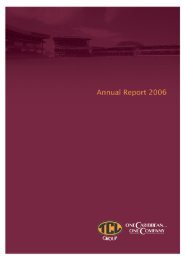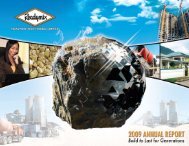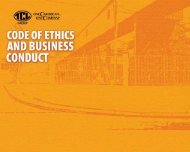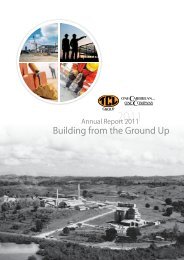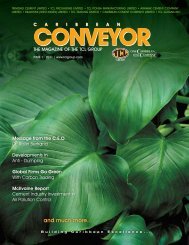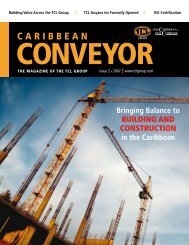Download File - TCL Group
Download File - TCL Group
Download File - TCL Group
You also want an ePaper? Increase the reach of your titles
YUMPU automatically turns print PDFs into web optimized ePapers that Google loves.
NOTES TO THE CONSOLIDATED FINANCIAL STATEMENTS<br />
FOR THE YEAR ENDED 31ST DECEMBER, 2010<br />
(Expressed in Thousands of Trinidad and Tobago Dollars, except where otherwise stated)<br />
(Continued)<br />
2. Significant accounting policies (continued)<br />
t) Impairment of assets<br />
Non–financial assets<br />
The <strong>Group</strong> assesses at each reporting date whether there is an indication that an asset may be impaired. If any such indication exists,<br />
or when annual impairment testing for an asset is required, the <strong>Group</strong> makes an estimate of the asset’s recoverable amount. An asset’s<br />
recoverable amount is the higher of an asset’s or cash generating unit’s fair value less costs to sell and its value in use and is determined<br />
for an individual asset, unless the asset does not generate cash inflows that are largely independent of those from other assets or groups<br />
of assets. When the carrying amount of an asset exceeds its recoverable amount, the asset is considered impaired and is written down<br />
to its recoverable amount. In assessing value in use, the estimated future cash flows are discounted to their present value using a pretax<br />
discount rate that reflects current market assessments of the time value of money and the risks specific to the asset.<br />
Impairment losses of continuing operations are recognized in the statement of income in those expense categories consistent with the<br />
function of the impaired asset.<br />
An assessment is made at each reporting date as to whether there is any indication that previously recognized impairment losses may<br />
no longer exist or may have decreased. If such indication exists, the <strong>Group</strong> makes an estimate of recoverable amount. A previously<br />
recognized impairment loss is reversed only if there has been a change in the estimates used to determine the asset’s recoverable<br />
amount since the last impairment loss was recognized. If that is the case the carrying amount of the asset is increased to its recoverable<br />
amount. That increased amount cannot exceed the carrying amount that would have been determined, net of depreciation, had no<br />
impairment been recognized for the asset in prior years. Such reversal is treated as a revaluation increase.<br />
Financial assets<br />
The carrying value of all financial assets not carried at fair value through the statement of income is reviewed for impairment<br />
whenever events or circumstances indicate that the carrying amount may not be recoverable. The identification of impairment and<br />
the determination of recoverable amounts is an inherently uncertain process involving various assumptions and factors, including the<br />
financial condition of the counterparty, expected future cash flows, observable market prices and expected net selling prices.<br />
u) Non-current assets held for sale and discontinued operations<br />
Non-current assets and disposal groups classified as held for sale are measured at the lower of their carrying amount and fair value<br />
less costs to sell. Non-current assets and disposal groups are classified as held for sale if their carrying amounts will be recovered<br />
principally through a sale transaction rather than through continuing use. This condition is regarded as met only when the sale is highly<br />
probable and the asset or disposal group is available for immediate sale in its present condition. Management must be committed to the<br />
sale, which should be expected to qualify for recognition as a completed sale within one year from the date of classification.<br />
In the consolidated income statement of the reporting period, and of the comparable period of the previous year, income and expenses<br />
from discontinued operations are reported separately from income and expenses from continuing operations, down to the level of<br />
profit after taxes, even when the <strong>Group</strong> retains a non-controlling interest in the subsidiary after the sale. The resulting profit or loss<br />
(after taxes) is reported separately in the income statement.<br />
Property, plant and equipment and intangible assets once classified as held for sale are not depreciated or amortised.<br />
v) Comparative information<br />
Certain changes in the presentation of comparative information have been made in these financial statements. These changes relate<br />
to the reclassification of an amount of $5.1 million previously presented within cash and cash equivalents, now presented within<br />
amounts due from related parties (note 18) as at 31 December 2009. This also resulted in a corresponding reduction in the cash and<br />
cash equivalents balance as at 31 December 2009.<br />
Comparatives were also amended in the consolidated income statement and related notes to reflect the separate presentation of the<br />
results of the discontinued operations as described in Note 25.<br />
These changes had no effect on the net assets or operating results of the previous year.<br />
23<br />
BUILD TO LAST FOR GENERATIONS



